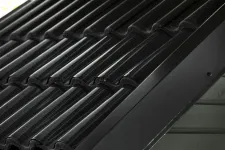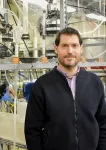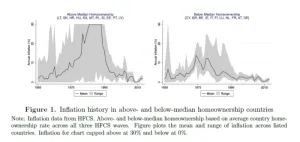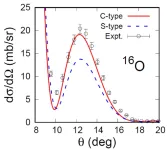(Press-News.org) By using a new method, precious metals can be efficiently recovered from thin-film solar cells. This is shown by new research from Chalmers University of Technology, Sweden. The method is also more environmentally friendly than previous methods of recycling and paves the way for more flexible and highly efficient solar cells.
Today there are two mainstream types of solar cells. The most common is silicon-based and accounts for 90 percent of the market. The other type is called thin-film solar cells which in turn uses three main sub-technologies, one of which is known as CIGS (Copper Indium Gallium Selenide), and consists of a layer of different metals, including indium and silver. Thin-film solar cells are by far the most effective of today's commercially available technologies. They can also be made bendable and adaptable, which means that they can be used in many different areas. The problem is that the demand for indium and silver is high, and increased production is accompanied by a growing amount of production waste, which contains a mixture of valuable metals and hazardous substances. Being able to separate attractive metals from other substances, therefore, becomes extremely valuable, both economically and environmentally, as they can be reused in new products.
“It is crucial to remove any contamination and recycle, so that the material becomes as clean as possible again. Until now, high heat and a large amount of chemicals have been used to succeed, which is an expensive process that is also not environmentally friendly”, says Ioanna Teknetzi, PhD student at the Department of Chemistry and Chemical Engineering, who together with Burcak Ebin and Stellan Holgersson published the new results in the journal Solar Energy Materials and Solar Cells.
Now their research shows that a more environmentally friendly recycling process can have the same outcome.
“We took into account both purity and environmentally friendly recycling conditions and studied how to separate the metals in the thin-film solar cells in acidic solutions through a much ‘kinder’ way of using a method called leaching. We also have to use chemicals, but nowhere near as much as with previous leaching methods. To check the purity of the recovered indium and silver, we also measured the concentrations of possible impurities and saw that optimisation can reduce these”, says Ioanna Teknetzi.
The researchers showed that it is possible to recover 100 percent of the silver and about 85 percent of the indium. The process takes place at room temperature without adding heat.
“It takes one day, which is slightly longer than traditional methods, but with our method, it becomes more cost-effective and better for the environment. Our hopes are that our research can be used as a reference to optimise the recycling process and pave the way for using the method on a larger scale in the future”, says Burcak Ebin.
The method
1. The film from the solar cell is analysed with respect to material, chemical composition, particle size and thickness. The solar cell is placed in a container with an acid solution at the desired temperature. Agitation is used to facilitate dissolution of metals in the acid solution. This process is called leaching.
2. Leaching effectiveness and chemical reactions are assessed by analysing samples taken at specific times during the leaching process. The different metals are leached at different times. This means that the process can be stopped before all the metals begin to dissolve, which in turn contributes to achieving higher purity.
3. When the leaching is complete, the desired metals are in the solution in the form of ions and can be easily purified to be reused in the manufacture of new solar cells.
More about the study
Valuable metal recycling from thin film CIGS solar cells by leaching under mild conditions has been published in Solar Energy Materials and Solar Cells. The authors are Ioanna Teknetzi, Burcak Ebin and Stellan Holgersson at the Department of Chemistry and Chemical Engineering at Chalmers University of Technology. The study has been carried out at Chalmers Material Analysis Laboratory, CMAL, and the research has received funding from the Swedish Energy Agency.
For more information, please contact:
Ioanna Teknetzi, PhD student, Department of Chemistry and Chemical Engineering, Chalmers University of Technology, ioanna.teknetzi@chalmers.se
Dr. Burcak Ebin, researcher, Department of Chemistry and Chemical Engineering, Chalmers University of Technology, +46 31 772 17 29, burcak@chalmers.se
Dr. Stellan Holgersson, researcher, Department of Chemistry and Chemical Engineering, Chalmers University of Technology, +46 31 772 28 02, stehol@chalmers.se
Caption: Thin-film solar cells are highly efficient and can be made bendable and adaptable, meaning they can be used in a wide range of areas, such as here on roof tiles. Photo of solar cells: Midsummer
END
Gentle method allows for eco-friendly recycling of solar cells
2023-04-13
ELSE PRESS RELEASES FROM THIS DATE:
Infant formulas promise too much
2023-04-13
Many infant formulas promise a lot. Several products claim that they help develop the brain, increase immunity and promote children's growth and development, among other things.
Now a research group led by Imperial College London has looked at whether these promises have any substance to them. The article has recently been published in BMJ.
“Most of the claims about the health-giving and nutritional properties of breast milk substitutes seem to be based on little or no evidence,” the research group says.
Claims surrounding these replacement milk products are controversial. They can give the impression ...
CESJ selected for the ERC grant to launch a European program of science journalists in residence
2023-04-13
Milan (Italy), 13 April 2023 – The Center for Ethics in Science and Science Journalism (CESJ, www.cesj.eu) is among the partners of the FRONTIERS consortium that was selected by the European Research Council for a grant of 1.5 million euro to establish a residency program for science journalists in research institutions across Europe, and measure its impact on the lifelong professional development of science journalism in Europe. The consortium also includes the NOVA University of Lisbon (Portugal), ...
Living through high inflation increases home ownership
2023-04-13
People who experience periods of high inflation are more likely to buy a home, according to a new study from the University of California San Diego’s Rady School of Management.
The paper, to be published in The Journal of Finance, uses various sources of data which reveal households that have been exposed to high inflation are more likely to invest in real estate. The study suggests many homeowners buy because they are motivated to protect themselves from possible future price hikes.
The study is the first to reveal that personal ...
Eastern wolves evolved separately from grey wolves
2023-04-13
A new paper in Molecular Biology and Evolution, published by Oxford University Press, provides interesting new evidence about the evolution of North American wolves, which has been a subject of debate among conservationists and taxonomists.
Southeastern Canada is home to populations of wolves and coyotes whose origins and genetic relationships have long puzzled scientists. In particular, eastern wolves have been the subject of great dispute, and it remains unknown whether these canids represent ...
Visualizing differences in nuclear structure
2023-04-13
Helium usually has two protons and two neutrons strongly bound to each other, often forming a substructure within the nucleus. A nucleus composed of several such substructures is called a cluster structure. In the standard picture, nuclei are difficult to understand in terms of so-called shell structure; because there was no way to clearly distinguish whether each nucleus has a cluster or a shell structure.
Associate Professor Wataru Horiuchi and Professor Naoyuki Itagaki from the Osaka Metropolitan University Graduate School of Science, have developed an ...
The Lancet Neurology: Identifying ‘hallmark’ Parkinson’s disease protein build-up could aid early detection and pave way for improved diagnosis and treatment
2023-04-13
Cross-sectional study of 1,123 participants confirms α-synuclein seed amplification assay (αSyn-SAA) technique is highly accurate at identifying people with Parkinson’s disease.
The technique detects at-risk individuals and those with early, non-motor symptoms of Parkinson’s disease prior to diagnosis, suggesting that a positive result on αSyn-SAA may be an early indicator of disease onset.
Differences in the frequency of a positive αSyn-SAA result were detected based on age and sex, and if people ...
Free trade deal is a major threat to UK public health, warn experts
2023-04-13
The UK’s decision to join one of the world’s largest free trade agreements, known as the Comprehensive and Progressive Agreement on Trans-Pacific Partnership (CPTPP), poses a major threat to UK public health, warn experts in The BMJ today.
In acceding to the CPTPP, the government hopes to boost trade, improve economic growth, and strengthen the UK’s strategic position as a global rule setter.
But Courtney McNamara and colleagues argue that free trade deals have serious and wide ranging implications for public health and ...
Female healthworkers need better radiation protection to minimise breast cancer risk
2023-04-13
Women working in healthcare who are regularly exposed to radiation from x-rays and other imaging procedures need better ionising radiation protection to help minimise their risk of developing breast cancer, argue doctors in The BMJ today.
Ionising radiation is a known human carcinogen and breast tissue is highly radiation sensitive. As such, there are concerns that regular exposure to ionising radiation during image guided procedures may be linked to a higher risk of breast cancer in female healthcare workers.
Personal protective equipment (PPE) such as lead gowns are used to shield the body from harmful radiation during these ...
Higher dose corticosteroids associated with a 60% increased risk of death in hypoxic COVID-19 patients requiring only non-invasive oxygen therapy (The Lancet / RECOVERY trial)
2023-04-13
*Note: this is a joint press release from the European Congress of Clinical Microbiology & Infectious Diseases (ECCMID) and The Lancet. Please credit both the congress and the journal in your stories*
A new study to be presented at this year’s European Congress of Clinical Microbiology & Infectious Diseases (ECCMID 2023, Copenhagen 15-18 April), and published in The Lancet, shows that, compared with standard care that included low dose corticosteroid use, treating hypoxic COVID-19 patients needing ...
Assisted reproduction kids grow up just fine – but it may be better to tell them early about biological origins, twenty-year study suggests
2023-04-13
Paper available at: https://drive.google.com/drive/folders/1y9GfgYkRdUtwyq6nBhySePTUHZYP6iAj?usp=share_link
Landmark study finds no difference in psychological wellbeing or quality of family relationships between children born by assisted reproduction (egg or sperm donation or surrogacy) and those born naturally at age 20.
However, findings suggest that telling children about their biological origins early – before they start school – can be advantageous for family relationships and healthy adjustment.
The study, by University of Cambridge researchers, is the first to examine the long-term ...





